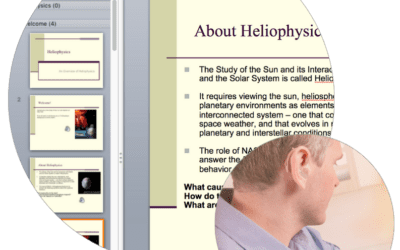How to overcome the skill, cost, and time barriers to producing accessible elearning courseware for Federal and State Government Agencies
ELearning is the cornerstone of training and education for federal and state government agencies. Ensuring that eLearning content is accessible to all individuals, including those with disabilities, remains a significant challenge.
This article explores the skill, cost, and time barriers that hinder the production of accessible eLearning content AT SCALE and presents CourseAvenue’s innovative approach to democratizing eLearning content creation.
The Challenges of Producing Accessible eLearning Content at Scale
Understanding Accessibility Requirements
Federal and state agencies are mandated to comply with Section 508 of the Rehabilitation Act, which requires electronic and information technology to be accessible to people with disabilities. ELearning content must meet the Web Content Accessibility Guidelines (WCAG) 2.0 Level AA standards. However, understanding and implementing these requirements can be daunting for individuals and organizations unfamiliar with accessibility standards.
Technical Complexity of Retrofitting Content
Most eLearning authoring tools burden the content author with knowing everything about Section 508/WCAG. Authors must be well-versed in accessibility standards and technical requirements to ensure compliance. The complexity of compliance makes this approach a non-starter for anyone other than seasoned programmers. (Re)creating accessible eLearning content includes multiple technical challenges. Here are just a few…
- Multimedia Accessibility: Videos and audio must have captions and transcripts for users who are deaf or hard of hearing. Descriptive audio may also be necessary for visual content.
- Interactive Elements: Quizzes, drag-and-drop activities, and simulations must be operable using keyboards and assistive technologies.
- Readability: Content must be readable by screen readers, requiring special tagging to ensure logical navigation and reading order.
- Visual Design: Adequate color contrast and the use of color must be considered to ensure information is not conveyed by color alone.
- Resource intensive: Developing accessible eLearning content usually requires additional resources in terms of time, budget, and specialized skills – including hiring accessibility experts, extending development and testing time, and potentially higher software or tool costs.
Creating Good Training is Hard
Subject Matter Experts (SMEs) or those close to the content often struggle to summarize or abstract detailed information into coherent elearning courseware. Typically, SMEs provide raw content, such as PowerPoint decks or audit findings, that dive into hyper-detailed explanations early on, making it challenging to create structured and engaging eLearning courses, resulting in content that is too detailed and specific, missing the broader learning objectives.
Continuous Monitoring and Updating
Accessibility is not a one-time task. eLearning content must be regularly updated to remain compliant, especially as technologies and standards evolve. This requires ongoing attention and resources.
Legal and Compliance Risks
Failure to comply with Section 508 can expose organizations to legal risks, including complaints and lawsuits. This adds a layer of compliance necessity that can be daunting for many organizations.
Training and Awareness
Developers and content creators often need to be trained on accessibility standards and best practices. A lack of awareness and understanding of accessibility principles can lead to non-compliant eLearning materials.
Cost and Effort Barriers
High Development Costs
The cost of developing accessible eLearning content can be prohibitive, especially for smaller agencies with limited budgets. The need for specialized tools and expertise further escalates costs.
Time-Consuming Processes
Ensuring accessibility compliance can significantly extend the development timeline with accessibility audits, remediation, and testing.
Complexity of Retrofitting
Retrofitting existing eLearning content to meet accessibility standards is often more complex and costly than creating accessible content from the outset. This process can involve extensive rework and redesign.
CourseAvenue: Easy-To-Create Accessible eLearning Content
CourseAvenue simplifies the eLearning creation process by enabling SMEs to convert their knowledge into instructionally sound and accessible courseware without requiring instructional design or technical programming skills. This underlying efficiency democratizes the content creation process, allowing more individuals to contribute to accessible eLearning.
CourseAvenue’s platform gives your SMEs power. Easy-to-create accessible eLearning content is now possible thanks to built-in accessibility features that ensure compliance with Section 508 and WCAG standards. This eliminates the need for accessibility remediation, reducing both time and cost.
Ease of Use Reduces the Cost of Creating eLearning Content
The platform’s user-friendly interface allows non-programmers to easily create SCORM-compliant courses that meet accessibility requirements. This includes automated auditing and real-time feedback to quickly identify and rectify accessibility issues.
Content Syndication and Sharing
CourseAvenue’s Syndication Manager allows agencies to share, customize, and collaborate on eLearning content. This reduces duplication of efforts and resources, leading to cost savings and increased efficiency.
Embrace Generative AI with the CourseAdvisor
Transforming dull subject matter into e-learning experiences is time-consuming and expensive, especially for Subject Matter Experts (SMEs) with no prior instructional design knowledge. CourseAvenue addresses this issue by using Generative AI to transform raw content into instructionally sound courseware, outlines, and more. This accelerates courseware timetables because SMEs can focus on validating and refining the material rather than starting from scratch.
Cost-Free Remediation Support
If a course created in CourseAvenue gets flagged for an accessibility audit, CourseAvenue will work with the author and the reviewer at no cost until the issue is resolved (learn more here). This eliminates the need for third-party remediation services, resulting in significant cost savings for the organization.
Continuous Support and Updates
CourseAvenue provides ongoing support and updates to ensure that eLearning content remains compliant with evolving accessibility standards. This includes training and resources to help organizations stay current with best practices.
The Financial Benefits of Easy-To-Create Accessible eLearning Content
Democratizing the production of accessible eLearning content offers numerous economic benefits for organizations, particularly for federal and state government agencies. By enabling a broader range of individuals to create high-quality, compliant eLearning materials, organizations can achieve significant cost savings, improve efficiency, and enhance the overall effectiveness of their training programs. The benefits span many dimensions.
Reduced Development Costs
Lower Personnel Costs: By empowering subject matter experts (SMEs) to create eLearning content without the need for specialized instructional designers or programmers, organizations can reduce the costs associated with hiring and retaining highly specialized staff.
Minimized Outsourcing: Organizations can reduce or eliminate the need to outsource eLearning development to external vendors, which can be costly and time-consuming.
Increased Efficiency
Easy-To-Create Accessible eLearning translates into two big benefits:
- Faster Content Creation: User-friendly platforms like CourseAvenue streamline the content creation process, allowing SMEs to produce eLearning materials more quickly. This reduces the time-to-market for training programs and enables organizations to respond more rapidly to training needs.
- Automated Compliance: Built-in accessibility features and automated compliance checks ensure that content meets Section 508 and WCAG standards without extensive manual intervention. This reduces the time and effort required for accessibility audits and remediation.
Enhanced Scalability
Scalable Solutions: Democratizing eLearning production allows organizations to scale their training programs more effectively. With more individuals capable of creating content, organizations can produce a larger volume of training materials to meet the needs of diverse audiences.
Content Syndication: CourseAvenue enables content syndication and sharing across departments and agencies. This reduces duplication of effort and allows organizations to leverage existing content, further enhancing scalability.
Improved Resource Allocation
Optimized Use of Expertise: By enabling SMEs to create eLearning content, organizations can better utilize their internal expertise. This allows instructional designers and technical staff to focus on more complex projects and strategic initiatives.
Reduced Training Costs: Training programs can be developed and deployed more cost-effectively, reducing the overall expenditure on training and development.
Compliance and Risk Mitigation
Avoidance of Legal Penalties: Ensuring that eLearning content is accessible and compliant with legal standards helps organizations avoid fines and legal challenges associated with non-compliance. This can result in significant cost savings and protect the organization’s reputation.
Consistent Quality: Automated compliance checks and built-in accessibility features ensure that all eLearning content meets high standards of quality and accessibility, reducing the risk of errors and inconsistencies.
Enhanced Employee Productivity
Accessible Training: Accessible eLearning content ensures that all employees, including those with disabilities, can participate in training programs. This enhances overall employee productivity and engagement.
Skill Development: By democratizing eLearning production, organizations can provide more training opportunities, helping employees develop new skills and improve their performance.
Long-Term Cost Savings
Sustainable Practices: Investing in platforms that democratize eLearning production can lead to long-term cost savings. As more employees become proficient in creating accessible content, the organization can continuously produce high-quality training materials without incurring additional costs.
Reduced Maintenance Costs: Accessible eLearning content is easier to update and maintain, reducing the long-term costs associated with content management and compliance.
Enhanced Organizational Agility
Rapid Response to Training Needs: Democratizing eLearning production allows organizations to quickly develop and deploy training programs in response to emerging needs or changes in regulations. This enhances organizational agility and ensures that employees are always equipped with up-to-date knowledge and skills.
Conclusion
Accessibility in eLearning is not just a legal requirement; it is a civil right. Ensuring that all individuals, regardless of their abilities, have access to educational content is essential for promoting inclusivity and equity.
Democratizing the production of accessible eLearning content offers substantial economic benefits for organizations.
By reducing development costs, increasing efficiency, enhancing scalability, and improving resource allocation, organizations can achieve significant cost savings and enhance the overall effectiveness of their training programs. Additionally, ensuring compliance and accessibility mitigates legal risks and enhances employee productivity, contributing to long-term organizational success. CourseAvenue plays a crucial role in this transformation, empowering a broader range of individuals to create high-quality, accessible eLearning content.
CourseAvenue’s innovative approach to eLearning content creation empowers SMEs to produce accessible and useful eLearning content, breaking down barriers and democratizing access to education. By leveraging CourseAvenue’s platform, federal and state government agencies can overcome the cost and effort barriers associated with accessibility and deliver high-quality, compliant eLearning content at scale.





